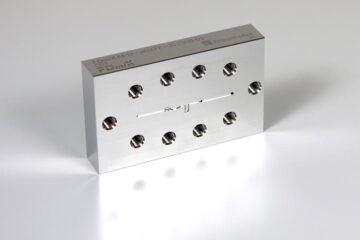Scientists work to detect mysterious neutrinos

Livermore scientists are working to solve a 50-year-old question: Can neutrinos – a particle that is relatively massless, has no electric charge yet is fundamental to the make-up of the universe – transform from one type to another?
Scientists are using two giant detectors, one at Fermi Lab and another in a historic iron mine in northern Minnesota, to work on the answer.
As part of the international team working on the Main Injector Neutrino Oscillation Search (MINOS) project, Lawrence Livermore National Laboratory researchers will use the detectors to explore the mysterious nature and properties of neutrinos. Namely, they will seek to discover how neutrinos “change flavors.”
Neutrinos come in three “flavors:” electron, muon and tau. Each is related to a charged particle, which gives the corresponding neutrino its name. Neutrinos are extremely difficult to detect because they rarely interact with anything. Though they can easily pass through a planet, solid walls and even a human hand, they rarely leave a trace of their existence. “The probability of a neutrino interacting with anything is very small,” said LLNL’s Peter Barnes, who along with Livermore’s Doug Wright and Ed Hartouni, is working on the MINOS experiment. “If you want to detect any neutrinos, you need something big.”
Barnes, Wright and Hartouni are hoping that something big is a 6,000-ton detector lying deep in the Soudan, Minn. mine. The neutrinos will be generated along the underground beam line at Fermi Lab, will pass through the near detector at Fermi, and will travel through the Earth to the detector in Minnesota. Neutrinos are more easily detected when they are generated at a high energy (such as those at Fermi Lab).
The MINOS scientists chose the distance to the far detector to maximize the oscillation probability, which gives them the best opportunity to directly study the neutrino “flavor change.”
Fusion in the sun results in electron neutrinos and scientists have predicted that if they can measure the electron neutrinos coming from the sun, they can measure the core of the sun. However, early experiments showed that less than half the expected neutrinos were observed on Earth. The idea that the missing electron neutrinos may have transformed into another type or “flavor” came alive.
This conclusion indicates that neutrinos do have some mass, small as it may be, in order for them to oscillate. So a portion of the electron neutrinos emitted from the sun could have changed flavors to muon or tau neutrinos before reaching Earth, thus solving the missing neutrino problem.
But it still doesn’t explain how or why this occurs, Barnes said. “Our goal is to understand the flavor oscillation properties of neutrinos,” he said.
Studying the elusive neutrino will help scientists better understand particle physics, specifically how particles acquire mass, as well as its role in the formation of the universe and its relationship to dark matter.
Media Contact
More Information:
http://www.llnl.govAll latest news from the category: Physics and Astronomy
This area deals with the fundamental laws and building blocks of nature and how they interact, the properties and the behavior of matter, and research into space and time and their structures.
innovations-report provides in-depth reports and articles on subjects such as astrophysics, laser technologies, nuclear, quantum, particle and solid-state physics, nanotechnologies, planetary research and findings (Mars, Venus) and developments related to the Hubble Telescope.
Newest articles

For microscopic organisms, ocean currents act as ‘expressway’ to deeper depths
New research shows how tiny plant-like organisms hitch a ride on ocean currents to reach darker and deeper depths, where they impact carbon cycling and microbial dynamics in the subtropical…

FDmiX: Fast, robust series production of nanoparticles
Nucleic acid-based medications such as mRNA vaccines are opening up new therapeutic approaches. These active ingredients must be enclosed inside nanoparticles to ensure that they get to where they are…

Sensor measures oxygen content of breath
Oxygen saturation in the blood that is either too low or too high can cause physical harm or even death. This is why patients’ oxygen concentraions are monitored continuously in…





















